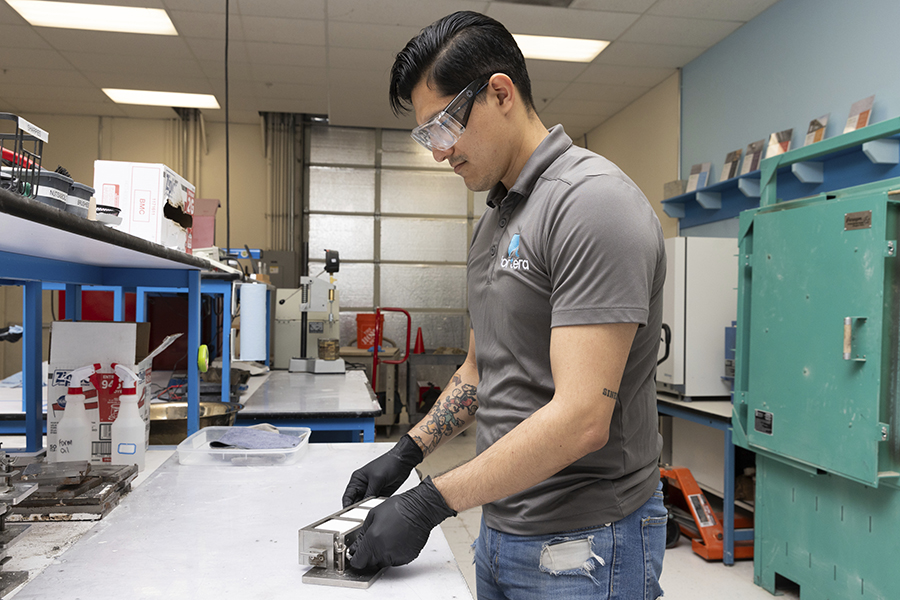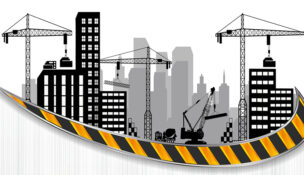West Coast startup touting greener building material
The Associated Press//April 12, 2024//

By Isabella O’Malley
The Associated Press
The cement industry is a major contributor to climate change – globally, it’s responsible for some 8 percent of carbon emissions each year. And demand for cement, a key ingredient in concrete, keeps growing as more buildings are constructed. So, industrial companies have sought new, cleaner ways to make concrete.
Now a California startup has developed a technology that reduces carbon dioxide in cement production and has the potential to operate at large scale. Fortera’s process intercepts carbon dioxide exhaust from the kilns where cement is made and then traps it in concrete during production. In the company’s first commercial-scale effort, the technology is being added to a CalPortland facility in Redding, California. Operations began on Friday.
“Our target is about being a ubiquitous solution that can work really at any plant,” Fortera CEO Ryan Gilliam said.
Fortera will initially produce enough of its product to mix with about one-fifth of CalPortland’s product in a blend that reduces carbon by about 10 percent. There is a strong demand for other blends that reduce carbon by 40 to 50 percent, and for another of the company’s products that reduces it by 70 percent, Gilliam said.
The first large sacks are scheduled to move out the door of the Redding plant the first week of May.
How the technology works
Cement manufacturers heat kilns to about 2,500 degrees Fahrenheit to break down limestone and separate it into carbon dioxide and calcium oxide.
Fortera’s process sucks the carbon dioxide out and pipes it into a machine where it is turned into a solid. Its technology works at around 1,800 degrees Fahrenheit, which requires less energy and emits less carbon.
When the captured carbon dioxide is mixed with calcium oxide, it turns into a kind of limestone that becomes cement-like when wet. This product, which Fortera calls ReAct, is blended with other ingredients to make concrete.
Fortera uses a 15 percent blend of ReAct in concrete because that is all that is allowed under existing industry standards that regulate material strength and durability. The company is trying to get a 100 percent ReAct product approved as a replacement for cement and says its testing has shown it can meet international requirements; however, the regulatory process will take over five years.
Fortera evolved in part out of another company called Calera that was among the first to convert carbon dioxide into cement starting in 2007. It poured some 100 tons of its low-carbon cement into California office buildings and sidewalks but shuttered in 2014 due to financial challenges. Building on that knowledge, Gilliam joined several former Calera employees to start Fortera in 2019.
Fortera’s effort is one of many to reduce the climate impact of concrete. One way that it’s different is that it offers at least the possibility of being installed widely at cement plants instead of changing how the industry currently runs.
There is “pretty much a cement plant every 250 miles in the world,” Gilliam said, and most are located near a limestone quarry. Because Fortera works with these existing plants and uses the same material the industry already uses, its technology is an economically competitive option to quickly reduce carbon emissions, he said.
A worldwide product, a worldwide problem
Concrete is the second-most used product on Earth, aside from water. Cement makes up 10-15 percent of concrete by volume, but accounts for 88 percent of concrete’s considerable emissions. Other ingredients in concrete are sand, gravel, crushed stone, and water.
Manufacturing one ton of cement emits nearly one ton of carbon dioxide. There hasn’t been a simple replacement.
“The societal benefits of concrete are absolutely immense … it’s the backbone of modern society,” said Thomas Guillot, CEO of the Global Cement and Concrete Association. Other materials sometimes fail to compete because they are not as durable, can’t support as much weight, or can’t stand up as well to heat, he said.
But some municipalities are urging changes. Vancouver, British Columbia, for instance, now has building standards that encourage lower-carbon concrete. California passed a law in 2021 that requires the state’s Air Resources Board to develop a strategy for the state’s cement industry to reduce its greenhouse gas emissions by 40 percent by 2035 and become net zero by 2045.
The First Movers Coalition, an organization of more than 90 companies, in 2021 announced an initiative to create greater demand for low-carbon cement through immense buying power. The same year, 40 of the largest cement and concrete manufacturers, through the Global Cement and Concrete Association, announced a commitment to making concrete that does not contribute to climate change by 2050. They agreed to reduce emissions from cement as well as fossil fuel use in manufacturing processes and develop new ways to capture carbon.
But some of the fastest-growing consumers of cement are in Southeast Asia and Africa, so global solutions are critical.
“The United States has to do what it can and be a leader to help other countries,” said Mike Ireland, president and CEO of the Portland Cement Association, the national trade association for U.S. cement manufacturers. “But we have to get the rest of the world, particularly the Global South, as they industrialize, to leapfrog some of the technologies we had.”
Carbon emissions from cement manufacturing is “an existential threat to the world and for our industry,” he said.
News
- Oregon housing production office opens
- Surfside condo collapse probe eyes construction flaws
- Oregon considering use of builder’s remedy to boost housing
- Tennessee racing venue becoming ballpark for game in August
- West Linn multifamily property fetches $33.6 million
- $26.9 million medical facility project in Portland building permits | June 30, 2025
- Multifamily property improvements in Portland land use review intakes | June 30, 2025
- Oregon lawmakers repeal wildfire hazard map
- Southern California delays gas appliance emission rules
- Building Blocks: St. Helens Riverwalk, phase 1
- $2.1 million public project in Seattle in top bidders | June 27, 2025
- Bull Run water project gets green light to resume
Commentary
- From birth dates to pay disclosures: new rules for employers | Opinion
- It’s warming up out there: heed heat and smoke rules | Opinion
- Change is not the enemy, but it is an inevitable force | Opinion
- Construction labor shortages: a primer for owners and contractors | Opinion
- Lessons on legal lot verification from Lane County | Opinion
- May drama unfolds: The market climbs a wall of confusion | Opinion
- Beware of bias at bat: when AI benches the wrong players | Opinion
- Oregon bill offers a lifeline for journalism — and democracy | Opinion
- The telltale signs of meaningful camaraderie | Opinion
- Lease of mind: Why developers should consider lease options in real estate agreements | Opinion
- Leave administration 101: laws, documentation, obligations | Opinion
- Addressing wage theft issues in the construction industry | Opinion














